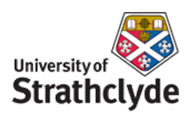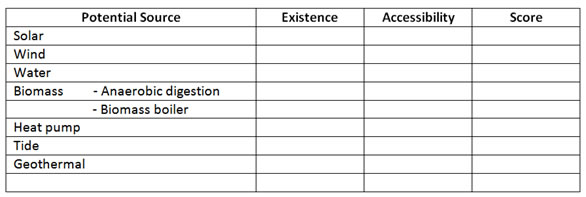

- General Considerations
- Specific Considerations

General Considerations - Assessing the Potential of Renewables
For assessing the potential use and application of small scale renewables in rural locations, it is important to have a primary overview in order to determine the sources and if they are able to be utilised effectively. This is the initial step for assessing the potential of renewables in the particular rural area before going into more detailed analysis in the next section (which is specific considerations).
Site characterisation
The following figure is for having a general view of the rural location to be assessed. It is to write a brief description of the mentioned characteristic.
Figure 1. Site Characterisation
Location
Date
Land Area
Topography
Site purpose
Occupancy
Agricultural practices
Farming indoor
Farming outdoors
Housing and building types
Building Fabrics
Heating / Cooling
Electrical appliances
Water supply
Legal issues
Environmental issues
Social issues
Others – if needed
- Topography: to see if the location is suitable or will influence the application of technologies.
- Agricultural practices: to see if there will be farming waste to use.
- Housing: to describe the types of dwelling ie. the number of stories, age, type of roof etc.
- Heating / Cooling: heating, cooling requirements.
- Water Supply: water requirements/source.
- Building fabrics: to see the energy efficiency of the building.
- Legal issues: to see if there are particular legal issues to take into account.
- Environmental issues: To see if there are particular environmental issues to take into account.
Note,
Present Energy Source
For having an idea of the present energy sources at the location:
Figure 2. Present Energy Source
Determine existing resources and their availability
The existence and accessibility of resources for small scale renewable technologies at the location of interest can be assessed using a scoring system:
Figure 3. Scoring System
Existence: Accessibility:
5: Identified immediately 5: It can be easily used
4: Easy to identify 4: It can be used with little constraints
3: Identified with the aid of instruments 3: May require additional technologies for it to be used
2: Difficult to identify 2: The source is not enough
1: Very difficult to identify 1: Cannot be used
Scoring:
It will be the addition of existence and availability scores
8 – 10: Maybe applicable
5 – 7: Deeper research is needed
1 – 4: Not applicable
Information needed
Figure 4. Information Needed
From owner
- Map
- Land useIf existing:
- Previous studies
- Technical information on demandsFrom owner, public databases or estimation
- Wind data
- Solar radiation data (direct and diffuse)
- Temperature records
- Rainfall data
- Soil conditions
- Ground water depth
- Superficial water flow (quantity and quality)
- Technical information on energy demands
| MSc: Renewable Energy Systems and the Environment | © University of Strathclyde 2010 |

